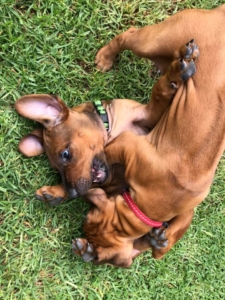Frequently Asked Questions
1. What is the temperament of a Rhodesian Ridgeback?
Rhodesian Ridgebacks are independent, intelligent, and confident dogs. They are typically very loyal to their families, protective, and reserved around strangers. With proper training, they can be affectionate and good with children, but their independent nature may require consistent leadership.
2. Are Rhodesian Ridgebacks good with children and other pets?
Rhodesian Ridgebacks are generally good with children, especially when raised with them. They are usually gentle and patient, but due to their size and strength, supervision is important. As for other pets, early socialization is key. While they can get along with other dogs and pets, their hunting instincts might be a concern around small animals.
3. How much exercise does a Rhodesian Ridgeback need?
Rhodesian Ridgebacks are high-energy dogs that require at least one to two hours of exercise each day. This can include walks, runs, or playtime in a secure, fenced area. They thrive on regular, vigorous activity and mental stimulation.
4. How big do Rhodesian Ridgebacks get?
Adult male Rhodesian Ridgebacks typically weigh between 38 to 50 kg, while females generally weigh between 29 to 40 kg. They stand around 60 to 70 cm tall at the shoulder.
5. Are Rhodesian Ridgebacks easy to train?
While Rhodesian Ridgebacks are intelligent, they can be independent and stubborn. This means training might require patience and consistency. Positive reinforcement techniques, such as treats and praise, work best. Early socialization and obedience training are essential to raising a well-behaved Ridgeback.
6. What is the lifespan of a Rhodesian Ridgeback?
The average lifespan of a Rhodesian Ridgeback is around 10 to 12 years. Like all breeds, their lifespan can vary depending on their overall health and care.
7. What grooming does a Rhodesian Ridgeback need?
Rhodesian Ridgebacks have short, dense coats that are relatively low-maintenance. Regular brushing once a week will help minimize shedding. They are considered a low-shedding breed. Routine care such as nail trimming, ear cleaning, and dental care should also be part of their grooming routine.
8. Are there any common health issues with Rhodesian Ridgebacks?
Rhodesian Ridgebacks are generally healthy, but they can be prone to certain genetic health issues, such as hip dysplasia, hypothyroidism, and certain types of cancer, including hemangiosarcoma. Regular vet checkups and a healthy diet can help manage these risks.
9. What should I feed my Rhodesian Ridgeback puppy?
Rhodesian Ridgeback puppies should be fed high-quality puppy food that supports their growth and development. Look for foods rich in protein and fats, and avoid fillers like corn and soy. Always consult your vet for specific feeding guidelines based on your puppy’s size and activity level.
10. How do I prepare my home for a Rhodesian Ridgeback puppy?
Before bringing a Rhodesian Ridgeback puppy home, ensure your space is puppy-proofed. Create a safe, comfortable sleeping area, secure any hazardous items, and have the necessary supplies ready, including a crate, food and water bowls, toys, and grooming tools.
11. Are Rhodesian Ridgebacks suited for apartment living?
While Rhodesian Ridgebacks are large dogs with high energy levels, they can adapt to apartment living as long as they get enough exercise. However, a home with a yard is ideal. If living in an apartment, daily exercise and mental stimulation are even more important to keep them content.
12. Do Rhodesian Ridgebacks require a lot of socialization?
Yes, early socialization is important for Rhodesian Ridgebacks. Exposing them to various environments, people, and animals from a young age helps prevent shyness or aggression toward strangers and other pets. Proper socialization also ensures they grow into confident and well-rounded adults.
13. Can Rhodesian Ridgebacks be left alone for long periods of time?
Rhodesian Ridgebacks are social dogs and do not like being left alone for long periods. If you work long hours, it’s important to ensure they have sufficient mental stimulation and exercise before you leave. If possible, arrange for a dog walker or pet sitter to keep them company.
14. What type of training is best for a Rhodesian Ridgeback?
Positive reinforcement is the most effective training method for Rhodesian Ridgebacks. They respond well to rewards such as treats, toys, and praise. Consistent training from a young age helps them learn commands and boundaries. Firm, yet gentle, leadership is key to managing their independent nature.
15. What are the exercise needs for a Rhodesian Ridgeback puppy?
As puppies, Rhodesian Ridgebacks need moderate exercise to avoid overstraining their developing bones and joints. Short walks and play sessions should be introduced gradually, increasing in duration and intensity as they grow. Be careful not to over-exercise them, especially during their first year.
16. How can I help my Rhodesian Ridgeback develop good behavior habits?
Establish routines and provide clear boundaries for your Rhodesian Ridgeback. Regular exercise, positive reinforcement, and consistent training will help encourage good behavior. Avoid harsh discipline as it may cause fear or anxiety; instead, focus on rewarding desirable behaviors.
17. What are the best toys or activities for Rhodesian Ridgebacks?
Rhodesian Ridgebacks enjoy interactive toys that challenge their minds, such as puzzle feeders or treat-dispensing toys. They also love outdoor activities, such as running, playing fetch, and participating in agility training. Mental stimulation through training sessions is also very beneficial for this intelligent breed.

